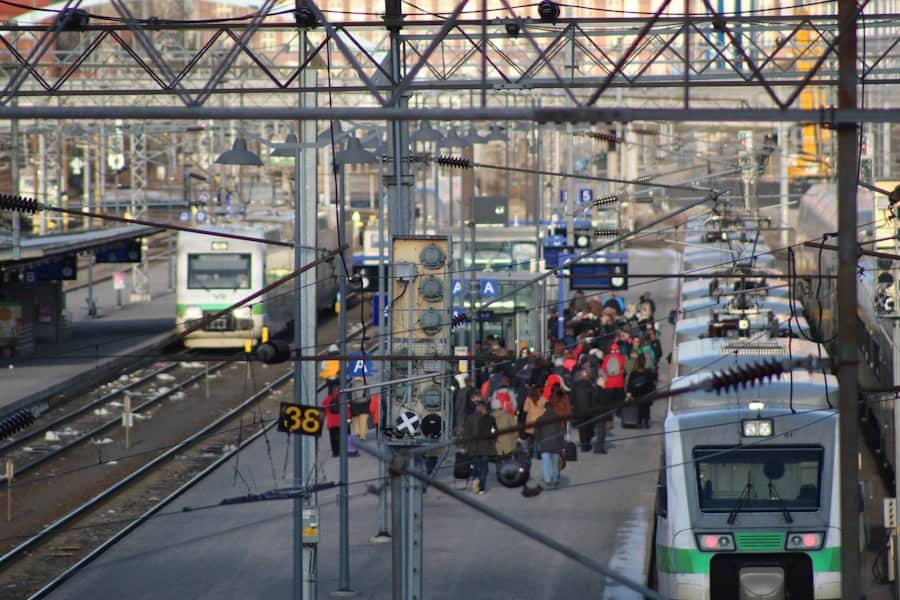The concept of smart cities has emerged as a pivotal response to the challenges posed by rapid urbanization, population growth, and climate change. Smart cities leverage advanced technologies and data analytics to enhance the quality of life for their residents while promoting sustainability. One of the most pressing issues that these urban environments face is the reduction of carbon emissions, which are a significant contributor to global warming and environmental degradation.
As cities expand, the demand for energy, transportation, and resources increases, leading to higher carbon footprints.
Carbon emissions in urban areas primarily stem from transportation, energy consumption in buildings, and waste management.
According to the United Nations, cities account for approximately 70% of global carbon emissions, making them critical battlegrounds in the fight against climate change. Smart cities aim to address this issue through innovative solutions that optimize resource use and minimize waste. By harnessing the power of technology, these urban centers can create a more sustainable future while improving the overall quality of life for their inhabitants.
The journey towards becoming a smart city involves a multifaceted approach that encompasses energy efficiency, sustainable transportation, waste management, and community engagement.
Key Takeaways
- Smart cities aim to reduce carbon emissions through the use of technology and sustainable solutions.
- Technology plays a crucial role in smart cities by enabling efficient energy usage and transportation solutions.
- Monitoring and managing energy usage is essential for smart cities to reduce carbon emissions and promote sustainability.
- Sustainable transportation solutions, such as electric vehicles and public transportation, are key in reducing carbon emissions in smart cities.
- Smart waste management systems and promoting renewable energy sources are important strategies for reducing carbon emissions in smart cities.
The Role of Technology in Smart Cities
Technology serves as the backbone of smart cities, enabling them to collect, analyze, and utilize data in real-time to improve urban living conditions. The Internet of Things (IoT) plays a crucial role in this transformation by connecting various devices and systems within the urban ecosystem. For instance, smart sensors can monitor air quality, traffic patterns, and energy consumption, providing city planners with valuable insights that inform decision-making processes.
This data-driven approach allows for more efficient resource allocation and helps identify areas where carbon emissions can be reduced. Moreover, advanced technologies such as artificial intelligence (AI) and machine learning are increasingly being integrated into urban management systems. These technologies can predict energy demand patterns, optimize traffic flow, and enhance public safety measures.
For example, AI algorithms can analyze historical traffic data to develop adaptive traffic signal systems that reduce congestion and lower vehicle emissions. By implementing such intelligent systems, smart cities can significantly decrease their carbon footprints while simultaneously improving the efficiency of urban operations.
Monitoring and Managing Energy Usage

Energy consumption is one of the largest contributors to carbon emissions in urban areas. Smart cities employ various strategies to monitor and manage energy usage effectively. Smart meters are a prime example of how technology can facilitate real-time energy tracking for both consumers and utility providers.
These devices provide detailed insights into energy consumption patterns, allowing residents to make informed decisions about their usage. By understanding peak usage times and identifying energy-intensive appliances, individuals can adjust their habits to reduce overall consumption. In addition to smart meters, building management systems equipped with IoT sensors can optimize energy use in commercial and residential buildings.
These systems can automatically adjust heating, ventilation, and air conditioning (HVAC) settings based on occupancy levels and external weather conditions. For instance, during periods of low occupancy, the system can reduce heating or cooling output, leading to significant energy savings. Furthermore, integrating renewable energy sources such as solar panels into building designs can further decrease reliance on fossil fuels and lower carbon emissions.
Implementing Sustainable Transportation Solutions
Transportation is another major source of carbon emissions in urban environments. Smart cities are increasingly adopting sustainable transportation solutions to mitigate this issue. One effective strategy is the development of integrated public transportation systems that utilize real-time data to enhance efficiency and accessibility.
By providing accurate information on transit schedules and routes through mobile applications, cities can encourage residents to opt for public transport over personal vehicles, thereby reducing traffic congestion and emissions. Additionally, smart cities are investing in electric vehicle (EV) infrastructure to promote cleaner transportation options. The installation of EV charging stations throughout urban areas encourages residents to transition from gasoline-powered vehicles to electric alternatives.
Cities like Amsterdam have successfully implemented extensive networks of charging stations, making it convenient for residents to charge their vehicles while reducing their carbon footprints. Furthermore, bike-sharing programs and pedestrian-friendly initiatives are being introduced to promote non-motorized forms of transportation, contributing to lower emissions and healthier lifestyles.
Smart Waste Management Systems
Waste management is a critical component of urban sustainability efforts, as landfills are significant sources of methane emissions—a potent greenhouse gas. Smart cities are leveraging technology to create efficient waste management systems that minimize waste generation and enhance recycling efforts. For instance, smart bins equipped with sensors can monitor waste levels in real-time and communicate with waste collection services when they need to be emptied.
This data-driven approach optimizes collection routes and schedules, reducing fuel consumption and emissions associated with waste collection vehicles. Moreover, smart waste management systems can facilitate better recycling practices by providing residents with information on proper disposal methods for various materials. Educational campaigns supported by mobile applications can guide citizens on how to recycle effectively and reduce contamination in recycling streams.
Cities like San Francisco have implemented comprehensive waste diversion programs that utilize technology to track waste generation patterns and improve recycling rates significantly.
Promoting Renewable Energy Sources

The transition to renewable energy sources is essential for reducing carbon emissions in smart cities. By investing in solar, wind, and other renewable technologies, urban areas can decrease their reliance on fossil fuels for electricity generation. Many smart cities are implementing community solar programs that allow residents to invest in shared solar installations, making renewable energy more accessible to those who may not have suitable rooftops for solar panels.
In addition to community solar initiatives, smart cities are exploring innovative financing models such as power purchase agreements (PPAs) that enable municipalities to procure renewable energy at competitive rates without upfront capital costs. For example, cities like Los Angeles have committed to sourcing 100% of their electricity from renewable sources by 2035 through such agreements. This ambitious goal not only reduces carbon emissions but also stimulates local economies by creating jobs in the renewable energy sector.
Engaging Citizens in Carbon Reduction Efforts
Citizen engagement is a vital aspect of successful carbon reduction strategies in smart cities. By involving residents in sustainability initiatives, cities can foster a sense of ownership and responsibility towards their environment.
For instance, campaigns encouraging energy conservation practices—such as turning off lights when not in use or using public transport—can lead to significant reductions in overall emissions. Furthermore, technology plays a crucial role in facilitating citizen engagement through platforms that allow residents to report issues related to sustainability or suggest improvements in their communities. Mobile applications can enable users to track their carbon footprints and participate in challenges aimed at reducing emissions collectively.
Cities like Barcelona have successfully implemented participatory budgeting processes that allow citizens to vote on sustainability projects they wish to see funded, ensuring that community needs are met while promoting environmental stewardship.
Challenges and Opportunities for Smart Cities in Reducing Carbon Emissions
While the potential for smart cities to reduce carbon emissions is significant, several challenges must be addressed to realize this vision fully. One major hurdle is the need for substantial investment in infrastructure and technology upgrades. Many existing urban environments may lack the necessary resources or political will to implement comprehensive smart city initiatives.
Additionally, disparities in access to technology can exacerbate inequalities within communities if not managed carefully. However, these challenges also present opportunities for innovation and collaboration among stakeholders. Public-private partnerships can play a crucial role in financing smart city projects while fostering innovation through shared expertise and resources.
Moreover, as global awareness of climate change continues to grow, there is an increasing demand for sustainable solutions that can drive economic growth while addressing environmental concerns. By embracing this momentum and leveraging technology effectively, smart cities have the potential not only to reduce carbon emissions but also to set a precedent for sustainable urban development worldwide. In conclusion, the journey towards creating smart cities that effectively reduce carbon emissions is complex yet filled with promise.
Through the integration of technology across various sectors—energy management, transportation, waste management, renewable energy promotion, and citizen engagement—urban areas can transform into sustainable environments that prioritize both ecological health and quality of life for their residents. The challenges faced along this path are significant but surmountable with collaborative efforts and innovative thinking aimed at fostering a greener future for all urban dwellers.
A related article to How Smart Cities Use Technology to Reduce Carbon Emissions is “The Best Laptop for Copywriters: Finding Your Perfect Writing Companion” which discusses the importance of having the right tools for writers to be productive and efficient. This article provides valuable insights into the best laptops that cater to the needs of copywriters, helping them excel in their craft. To learn more about the best laptops for copywriters, check out the article here.
FAQs
What are smart cities?
Smart cities are urban areas that use technology and data to improve the quality of life for their residents, enhance sustainability, and reduce carbon emissions.
How do smart cities use technology to reduce carbon emissions?
Smart cities use technology such as IoT (Internet of Things) sensors, smart grids, and data analytics to optimize energy usage, reduce waste, improve transportation systems, and promote sustainable practices.
What are some examples of technology used in smart cities to reduce carbon emissions?
Examples of technology used in smart cities include smart traffic management systems, energy-efficient buildings, electric vehicle charging stations, waste management systems, and renewable energy sources.
What are the benefits of using technology to reduce carbon emissions in smart cities?
The benefits of using technology to reduce carbon emissions in smart cities include improved air quality, reduced energy consumption, lower greenhouse gas emissions, and a more sustainable and livable urban environment.
How do smart cities measure the impact of technology on reducing carbon emissions?
Smart cities use data analytics and monitoring systems to measure the impact of technology on reducing carbon emissions. This includes tracking energy usage, transportation patterns, waste management, and air quality.

